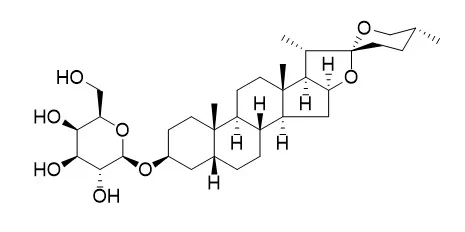| In vitro: |
| Zhongguo Zhong Yao Za Zhi. 2016 Apr;41(7):1241-1245. | | Screening and identification of DPP-4 inhibitors from Xiaokean formula by a fluorescent probe.[Pubmed: 28879738] | Fluorescent bio-probes have attracted increasing attentions in studies for screening bioactive compounds from traditional Chinese medicines.
METHODS AND RESULTS:
In this study, a new-type fluorescent probe with the function of aggregation-induced emission (AIE) was used to screen dipeptidyl peptidase-4 (DPP-4) inhibitor from Xiaokean formula, which has been clinically used for the treatment of type 2 diabetes mellitus.
Potential DPP-4 inhibitors were screened by the fluorescent probe, with diprotin A as the positive control; totally 43 components were isolated from Xiaokean formula by systematic separation. The results showed that 13 components can exert inhibitory effects on DPP-4 activity; 16 compounds were further identified by liquid chromatography-mass spectrometry (LC-MS) from those active components. The inhibitory effects of 14 compounds were further verified, while five of them showed significant inhibition against DPP-4. Salvianolicacid C, ginsenoside Rg₅ and Timosaponin AI inhibited DPP-4 activity at the concentration of 5-50 μmol•L⁻1 in a dose-dependent manner.
CONCLUSIONS:
Thus, our study provided a successful example for screening bioactive compounds from traditional Chinese medicines by using a novelfluorescent probe. | | Process Biochemistry, 2015, 50(12):2182-2187. | | Preparation of some metabolites of Timosaponin BII by biotransformation in vitro.[Reference: WebLink] |
Timosaponin BII (TBII) is an active constituent of some Chinese medicinal herbs, and is abundant in Anemarrhena asphodeloides Bunge.
METHODS AND RESULTS:
To better understand the pharmaceutical mechanisms of TBII, we prepared its deglycosylated derivatives through biotransformation with fungi Colletotrichum gloeosporioides, Acremonium alternatum and Aspergillus niger. In the presence of 10. g/L glucose, transformation with C. gloeosporioides yielded 4 products: Timosaponin AIII (P3) and Timosaponin AI (P5) and their beta isoforms (P2 and P4 respectively). However, P4 and P5 could not be detected when 0-5. g/L glucose was applied; P2 and P3 disappeared at 20. g/L glucose. P4 is a newly discovered compound.
CONCLUSIONS:
We firstly report that fungi in whole cell model can hydrolyze C3-. O-glucopyranosyl residues of steroidal saponins after removing the C26 sugar. Therefore, the transformation efficiency depends on glucose. Transformation of TBII, and maybe other steroidal saponins, with C. gloeosporioides is an ideal method to prepare the metabolites in vitro. |
|






 Cell. 2018 Jan 11;172(1-2):249-261.e12. doi: 10.1016/j.cell.2017.12.019.IF=36.216(2019)
Cell. 2018 Jan 11;172(1-2):249-261.e12. doi: 10.1016/j.cell.2017.12.019.IF=36.216(2019) Cell Metab. 2020 Mar 3;31(3):534-548.e5. doi: 10.1016/j.cmet.2020.01.002.IF=22.415(2019)
Cell Metab. 2020 Mar 3;31(3):534-548.e5. doi: 10.1016/j.cmet.2020.01.002.IF=22.415(2019) Mol Cell. 2017 Nov 16;68(4):673-685.e6. doi: 10.1016/j.molcel.2017.10.022.IF=14.548(2019)
Mol Cell. 2017 Nov 16;68(4):673-685.e6. doi: 10.1016/j.molcel.2017.10.022.IF=14.548(2019)